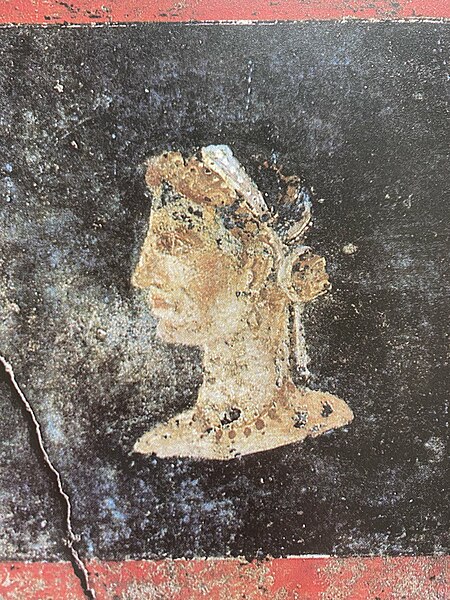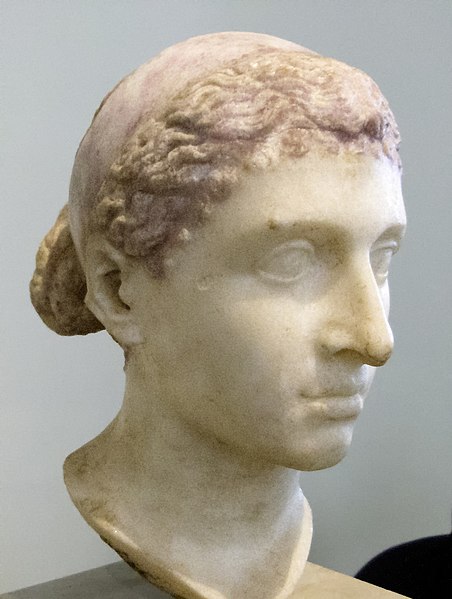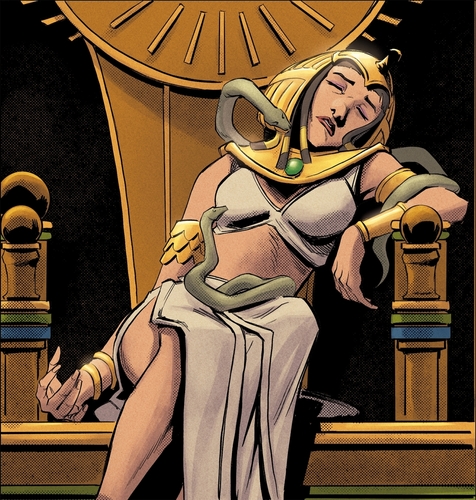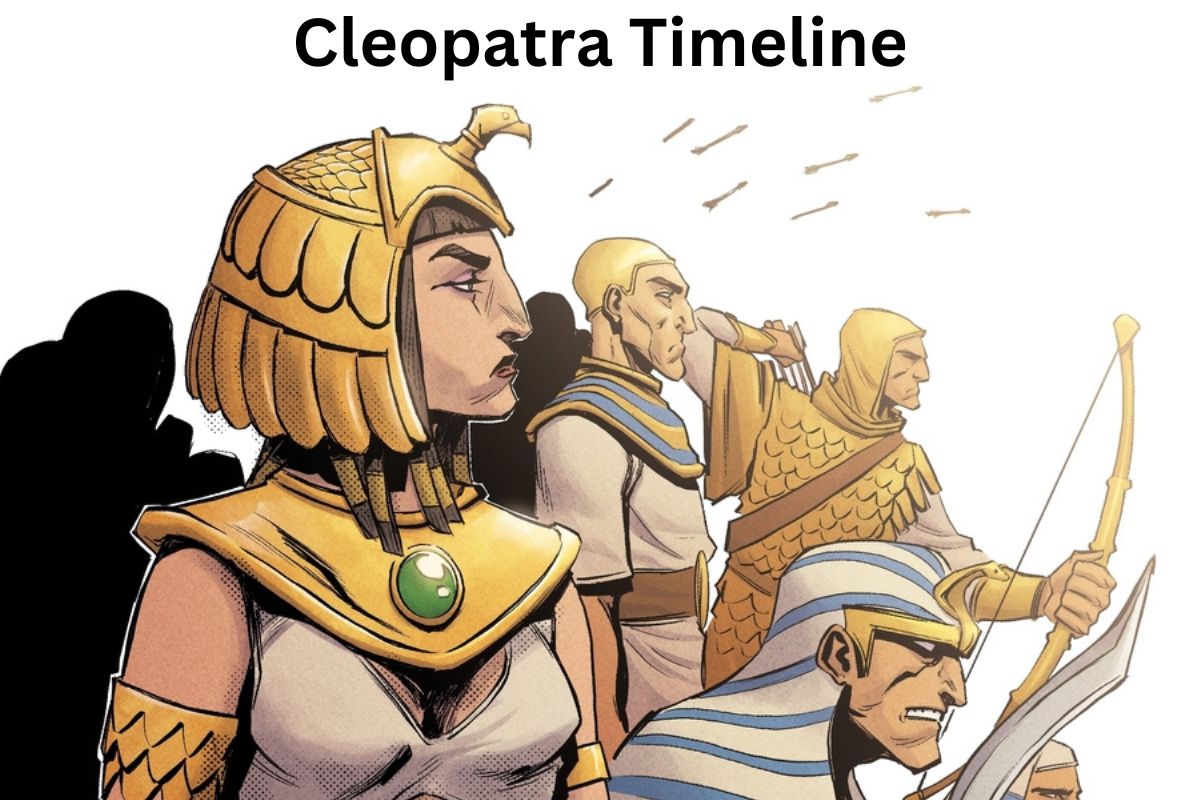Cleopatra was the last active pharaoh of Ancient Egypt. Born in 69 BCE, she ruled alongside her brother Ptolemy XIII.
After being exiled, Cleopatra sought the support of Julius Caesar and returned to Egypt, defeating her brother’s forces. She had a son with Caesar named Caesarion.
Cleopatra formed a powerful alliance with Mark Antony, but they were ultimately defeated by Octavian.
Facing defeat, Cleopatra died by suicide in 30 BCE, marking the end of the Ptolemaic dynasty.
Her life remains a captivating symbol of power and the complex relationship between Egypt and Rome.
| Year | Event |
|---|---|
| 69 BCE | Cleopatra is born in Alexandria, Egypt. |
| 51 BCE | Cleopatra becomes co-regent of Egypt with her brother, Ptolemy XIII. |
| 48 BCE | Cleopatra seeks assistance from Julius Caesar after being overthrown by her brother. |
| 47 BCE | Cleopatra returns to Egypt with Caesar’s support and defeats her brother’s forces. |
| 46 BCE | Cleopatra gives birth to a son named Caesarion, believed to be the child of Julius Caesar. |
| 44 BCE | Julius Caesar is assassinated in Rome. |
| 41 BCE | Cleopatra meets Mark Antony and they begin a romantic relationship. |
| 37 BCE | Cleopatra gives birth to twins, Alexander Helios and Cleopatra Selene. |
| 34 BCE | Cleopatra and Mark Antony hold the “Donations of Alexandria” celebration. |
| 31 BCE | Cleopatra and Mark Antony are defeated by Octavian in the Battle of Actium. |
| 30 BCE | Cleopatra and Mark Antony commit suicide; Cleopatra dies on August 12, 30 BCE. |
Timeline of Queen Cleopatra VII
69 BCE – Cleopatra is born in Alexandria, Egypt
She is born into the Ptolemaic dynasty, a Greek dynasty that ruled Egypt following the death of Alexander the Great.
Cleopatra is the daughter of Ptolemy XII Auletes, who was the pharaoh of Egypt at the time, and her mother is believed to be Cleopatra V Tryphaena.
As a member of the royal family, Cleopatra receives a classical education, learning various languages, including Egyptian, Greek, and possibly Latin.

51 BCE – Cleopatra becomes co-regent of Egypt with her younger brother, Ptolemy XIII
At the time, Cleopatra is around 18 years old, while Ptolemy XIII is about 10 years old. According to Egyptian tradition and the family customs of the Ptolemaic dynasty, siblings often marry to maintain the purity of the royal bloodline.
Thus, Cleopatra and Ptolemy XIII are married, and together they rule Egypt. However, the power dynamics between the siblings are strained, with Ptolemy XIII’s advisers gaining influence and attempting to diminish Cleopatra’s authority.
48 BCE – Cleopatra seeks assistance from Julius Caesar after being overthrown by her brother
Cleopatra’s reign faces challenges as Ptolemy XIII and his advisers grow more powerful. Cleopatra’s attempts to assert her authority and make independent decisions are met with resistance.
Faced with the threat to her throne, Cleopatra decides to take action. She gathers a loyal army and flees Egypt to seek external support to regain her position.
47 BCE – Cleopatra returns to Egypt with Caesar’s support and defeats her brother’s forces
After being forced into exile by her younger brother Ptolemy XIII and his advisers, Cleopatra seeks assistance from Julius Caesar, who is in Alexandria during his campaign against the forces of Pompey.
Recognizing Cleopatra’s legitimacy as the rightful ruler of Egypt, Caesar offers his support and military aid to help her regain her throne.
With Caesar’s backing, Cleopatra gathers a loyal army and sets sail for Egypt. Landing on Egyptian soil, she faces the forces of Ptolemy XIII in a decisive battle near Alexandria.
Cleopatra’s strategic acumen and the support of Caesar’s seasoned troops lead to a resounding victory, securing her position as the rightful co-ruler of Egypt.
Cleopatra’s successful return to power not only reestablishes her authority but also demonstrates her resourcefulness and resilience in the face of adversity.
The victory also solidifies her alliance with Julius Caesar, as he becomes personally involved in Egyptian affairs, ensuring the continued stability and prosperity of Egypt under Cleopatra’s reign.

46 BCE – Cleopatra gives birth to a son named Caesarion, believed to be the child of Julius Caesar
The birth of Caesarion marks a significant moment in Cleopatra’s life and adds a new layer of complexity to the political landscape of the time.
Caesarion, whose name means “Little Caesar,” is widely believed to be the biological son of Julius Caesar. Cleopatra had a romantic relationship with Caesar during his visit to Egypt in 48 BCE, and their alliance was driven not only by political motives but also by personal connection.
The birth of Caesarion solidifies Cleopatra’s claim to a powerful Roman figure’s lineage and potentially offers a path to secure her son’s future as an heir to both Egypt and Rome.
Cleopatra strategically presents Caesarion as the rightful heir to Julius Caesar, which challenges Octavian’s (later known as Augustus) claim to power in Rome.
44 BCE – Julius Caesar is assassinated in Rome
Cleopatra, who had returned to Egypt after her victory over Ptolemy XIII, faces a period of uncertainty.
With Caesar’s death, the Roman Republic is thrown into chaos, and Cleopatra must navigate the shifting political landscape to safeguard her position and the interests of Egypt.
Cleopatra’s son with Julius Caesar, Caesarion, is now a potential heir to the Roman Empire, which adds another layer of complexity to her situation.
41 BCE – Cleopatra meets Mark Antony and they begin a romantic relationship
Cleopatra’s path crosses with Mark Antony, one of the triumvirs ruling Rome after the power struggle that followed Caesar’s assassination. Cleopatra, aware of the importance of establishing alliances with influential Roman leaders, invites Antony to visit Egypt.
Their meeting sparks a passionate and intense romance, and they form a political and romantic partnership that would profoundly impact the course of their lives.
37 BCE – Cleopatra gives birth to twins, Alexander Helios and Cleopatra Selene
Cleopatra gives birth to twins, a son named Alexander Helios and a daughter named Cleopatra Selene. The birth of these children further solidifies Cleopatra and Mark Antony’s bond and cements their vision of a powerful dynasty that would link the Roman and Egyptian worlds.
Cleopatra and Mark Antony publicly present their children as heirs to various territories, thereby establishing their royal lineage and aspirations for a future empire.
Cleopatra’s children become a symbol of the union between Egypt and Rome, and Cleopatra strategically uses their birth to strengthen her position both within Egypt and on the international stage.
The twins’ names reflect Cleopatra and Mark Antony’s ambition, with Alexander Helios evoking the legendary conqueror Alexander the Great, and Cleopatra Selene representing the moon goddess, a symbol of power and fertility.

34 BCE – Cleopatra and Mark Antony hold the “Donations of Alexandria” celebration
During this lavish event, they publicly proclaim their mutual love and distribute kingdoms and territories among their children, including Egypt, Cyprus, parts of Syria, and other regions. Cleopatra is declared the “Queen of Kings,” solidifying her status as a powerful ruler alongside Mark Antony.
The “Donations of Alexandria” showcase Cleopatra’s diplomatic and political skills as she strategically reinforces her and Mark Antony’s legitimacy as rulers while aiming to gain the loyalty and support of key allies.
However, these actions also raise concerns in Rome, as they challenge the power and authority of Octavian (later known as Augustus), who is emerging as the sole ruler of the Roman Empire.
31 BCE – Cleopatra and Mark Antony are defeated by Octavian in the Battle of Actium
The Battle of Actium takes place, marking a critical turning point in Cleopatra’s life. Octavian, the adopted son and heir of Julius Caesar, leads the Roman forces against Cleopatra and Mark Antony.
The battle takes place near Actium, Greece. Despite Cleopatra’s support and a sizable fleet, Antony’s forces are decisively defeated. The defeat leaves Cleopatra and Mark Antony’s position in a precarious state, and they retreat to Egypt.
30 BCE Cleopatra and Mark Antony commit suicide; Cleopatra dies on August 12, 30 BCE
ctavian, now the undisputed leader of the Roman Empire, invades Egypt with a powerful Roman army. Facing the inevitable fall of Alexandria and the loss of their power, Cleopatra and Mark Antony take their own lives.
According to historical accounts, Cleopatra famously dies by allowing an asp, a venomous snake, to bite her, thus ending her life. Mark Antony dies shortly afterward.
Cleopatra’s decision to take her own life is often seen as a final act of defiance and an effort to maintain control over her fate. By avoiding capture and the potential humiliation of being paraded through Rome as a conquered ruler, Cleopatra preserves her legacy and retains a measure of dignity in death.
Following Cleopatra’s death, Egypt falls under Roman control. Octavian, now known as Augustus, becomes the first emperor of the Roman Empire. Egypt is transformed into a Roman province, marking the end of the Ptolemaic dynasty and the last independent reign of an Egyptian pharaoh.
Cleopatra’s children, including Caesarion and her twins with Mark Antony, are taken to Rome as captives by Augustus. Although initially spared, Caesarion is later executed on Augustus’ orders, ensuring that there are no direct heirs who could challenge Augustus’ authority.
Cleopatra’s children with Mark Antony, Alexander Helios, Cleopatra Selene, and Ptolemy Philadelphus, are raised in Rome under the care of Octavia, Octavian’s sister.
The final events in Cleopatra’s life and the aftermath of her death underscore the end of an era for Egypt and the consolidation of Roman power. Cleopatra’s tragic demise cements her reputation as a legendary figure in history, known for her intelligence, charm, and political acumen, as well as her romantic relationships with two of the most prominent Roman leaders of her time.
